

Muhammad ibn Zakariya al-Razi. Being endowed by nature with a comprehensive mind, Razi made fundamental and enduring contributions to various fields of science, which he recorded in over 200 manuscripts, and is particularly remembered for numerous advances in medicine through own observations and discoveries.[7] An early proponent of experimental medicine, he became a successful doctor; was appointed a court physician, and served as chief physician of Baghdad and Rey hospitals.[2][8] He was among the first to use Humoralism to distinguish one contagious disease from another and has been described as doctor's doctor,[9] the father of pediatrics,[10] and a pioneer of ophthalmology.

Biography[edit] Laika. Soviet space dog Laika (Russian: Лайка; c. 1954 – 3 November 1957) was a Soviet space dog who became one of the first animals in space, and the first animal to orbit the Earth.
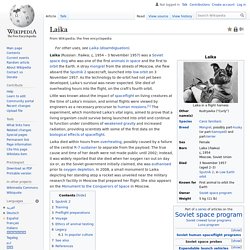
Laika, a stray mongrel from the streets of Moscow, was selected to be the occupant of the Soviet spacecraft Sputnik 2 that was launched into outer space on 3 November 1957. Codex Atlanticus. Saturn's hexagon. Saturn - North polar hexagon and vortex as well as rings (April 2, 2014).
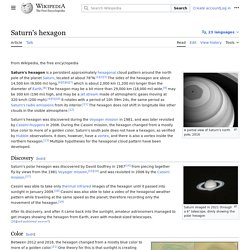
Saturn's hexagon is a persisting hexagonal cloud pattern around the north pole of the planet Saturn, located at about 78°N.[1][2][3] The sides of the hexagon are about 14,500 km (9,000 mi) long,[4][5][6][7] which is more than the diameter of Earth[8] (about 12,700 km (7,900 mi)). The hexagon may be a bit greater than 29,000 km (18,000 mi) wide,[9] may be 300 km (190 mi) high, and may be a jet stream made of atmospheric gases moving at 320 km/h (200 mph).[4][5][10] It rotates with a period of 10h 39m 24s, the same period as Saturn's radio emissions from its interior.[11] The hexagon does not shift in longitude like other clouds in the visible atmosphere.[12] Saturn's hexagon was discovered during the Voyager mission in 1981 and was later revisited by Cassini-Huygens in 2006.
Johann Georg Faust. Title page of one of the Höllenzwang grimoires attributed to D.
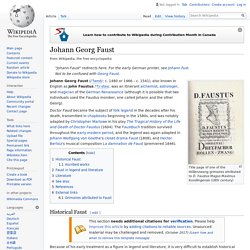
Faustus Magus Maximus Kundlingensis (18th century) Historical Faust[edit] Because of his early treatment as a figure in legend and literature, it is very difficult to establish historical facts about his life with any certainty. In the 17th century, it was even doubted that there ever had been a historical Faust, and the legendary character was identified with a printer of Mainz called Johann Fust. Johann Georg Neumann in 1683 addressed the question in his Disquisitio historica de Fausto praestigiatore, establishing Faust's historical existence based on contemporary references.
Cosmogony. Cosmogony (or cosmogeny) is any model concerning the coming-into-existence (i.e. origin) of either the cosmos (i.e. universe), or the so-called reality of sentient beings.[1][2] Developing a complete theoretical model has implications in both the philosophy of science and epistemology.

Etymology[edit] Tesla Memorial Society of New York. Introduction - The WRC site - Walter Russell. Walter Russell. The Secret of Nikola Tesla Movie Interesting. The Secret of Nikola Tesla (Serbo-Croatian: Tajna Nikole Tesle), is a 1980 Yugoslav biographical film which details events in the life of the Serbian-American engineer and inventor Nikola Tesla (1856–1943), portrayed by Serbian actor Petar Božović.
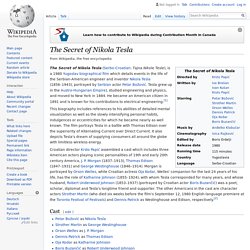
Tesla grew up in the Austro-Hungarian Empire), studied engineering and physics, and moved to New York in 1884. He became an American citizen in 1891 and is known for his contributions to electrical engineering.[1] This biography includes references to his abilities of detailed mental visualization as well as the slowly intensifying personal habits, indulgences or eccentricities for which he became nearly as well known. Nikola Tesla. Nikola Tesla (Serbian Cyrillic: Никола Тесла; 10 July 1856 – 7 January 1943) was a Serbian-American[3][4] inventor, electrical engineer, mechanical engineer, physicist, and futurist who is best known for his contributions to the design of the modern alternating current (AC) electricity supply system.[5] Born and raised in the Austrian Empire, Tesla received an advanced education in engineering and physics in the 1870s and gained practical experience in the early 1880s working in telephony and at Continental Edison in the new electric power industry.

He emigrated to the United States in 1884, where he would become a naturalized citizen. He worked for a short time at the Edison Machine Works in New York City before he struck out on his own. With the help of partners to finance and market his ideas, Tesla set up laboratories and companies in New York to develop a range of electrical and mechanical devices. Early years Tesla's baptismal record, 28 June 1856 Working at Edison. Cosmos: A Spacetime Odyssey. Cosmos: A Spacetime Odyssey is a 2014 American science documentary television series.[1] The show is a follow-up to the 1980 television series Cosmos: A Personal Voyage, which was presented by Carl Sagan on the Public Broadcasting Service and is considered a milestone for scientific documentaries.

This series was developed to bring back the foundation of science to network television at the height of other scientific-based television series and films. The show is presented by astrophysicist Neil deGrasse Tyson, who, as a young college student, was inspired by Sagan. Among the executive producers are Seth MacFarlane, whose clout and financial investment were instrumental in bringing the show to broadcast television, and Ann Druyan, Sagan's widow and a co-creator of the original series.[2][3] The show is produced by Brannon Braga, and Alan Silvestri provides the backing score.[4] The series premiered on March 9, 2014,[5] simultaneously in the US across ten 21st Century Fox networks.
The Brain with David Eagleman. The Brain with David Eagleman is a PBS documentary series created and presented by neuroscientist Dr.

David Eagleman. The Skeptic's Dictionary. Biological Cybernetics (Biocybernetics) Biocybernetics - Wikipedia. Biocybernetics is the application of cybernetics to biological science, composed of biological disciplines that benefit from the application of cybernetics including neurology and multicellular systems.
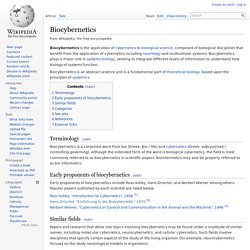
Biocybernetics plays a major role in systems biology, seeking to integrate different levels of information to understand how biological systems function. Biocybernetics - Wikipedia. Superorganism - Wikipedia. A termite mound made by the cathedral termite A coral colony A superorganism is an organism consisting of many organisms. Buckminster Fuller. Richard Buckminster Fuller (/ˈfʊlər/; July 12, 1895 – July 1, 1983)[1] was an American architect, systems theorist, author, designer, inventor and futurist. Fuller was the second World President of Mensa from 1974 to 1983.[2] Guinea Pig B: I AM NOW CLOSE TO 88 and I am confident that the only thing important about me is that I am an average healthy human. I am also a living case history of a thoroughly documented, half-century, search-and-research project designed to discover what, if anything, an unknown, moneyless individual, with a dependent wife and newborn child, might be able to do effectively on behalf of all humanity that could not be accomplished by great nations, great religions or private enterprise, no matter how rich or powerfully armed.
Buckminster Fuller.